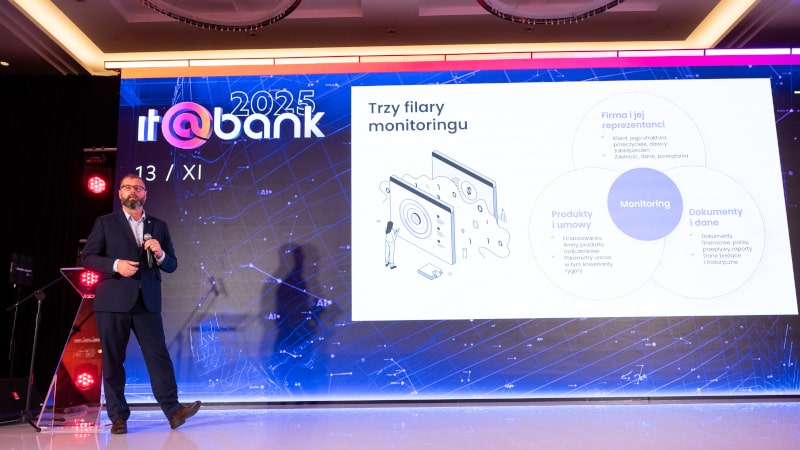On 13 November, we had the pleasure of partnering with the IT@Bank conference, where we shared our perspective on building an effective process for monitoring corporate clients. Our speaker, Jakub Rabong, walked the audience through what the post-sales journey looks like in practice, and what challenges banks face when data originating from a single agreement begins to live simultaneously across multiple systems.
In our presentation, we emphasized that monitoring does not begin when a problem occurs or when contractual conditions are breached. It starts much earlier — at the moment the bank activates financing, a limit, or funds resulting from the contract. From that point onwards, a stage begins that is often underestimated, yet in reality determines both the quality of cooperation with the client and the stability of the portfolio.
This is the moment when contract data flows into numerous systems, and every event — on the client’s side or on the bank’s side — can trigger subsequent steps in the process.
We showed that the client is usually the primary driver of change: they provide documents, submit applications, raise requests, and initiate events that then need to be processed by multiple bank teams — the relationship manager, analyst, monitoring team, credit operations, collections, and sometimes even crisis-response units such as complaints teams. All of them co-create a process that ultimately informs risk-related and compliance-related decisions.
During the session, we clarified what exactly should be monitored — above all, what has been contractually agreed: financing parameters, covenants, required documents and collateral, insurance policies, and operational data that shape the assessment of the client’s situation. These elements form the foundation of every data architecture and every monitoring model.
We also presented our perspective — the three key areas that we always consider when designing monitoring processes and systems. These are:
- the company and its representatives, responsible for collaboration and information flow;
- the products and credit decisions, which define the required actions and next steps;
- the documents and data, which are the basis for all assessments and decisions.
On top of these elements, we build decision-making processes and the data architecture that enables the bank to monitor both risk and contractual compliance.
A crucial part of the presentation was illustrating what — in our view — a complete and efficient monitoring process should look like. The key is to consolidate data from multiple sources into a coherent model that enables swift decision-making while remaining flexible enough to adapt to changes on the client’s side. Effective monitoring, in our view, means responding to data rather than waiting for issues to escalate — and having clear rules defining when a bank may consider a client’s obligations fulfilled, and when it must activate safeguards, from additional collateral to parameter updates, and ultimately to collections.
Through real-world examples, we demonstrated how this process can look different across institutions — from fully automated setups to hybrid workflows and solutions still heavily based on documents and spreadsheets. Each bank operates differently, but the objective is the same: protecting the bank’s interests while maintaining a healthy, partnership-based client relationship.
In closing, we highlighted what we consider the guiding principle and foundation of the entire talk: many data points, many systems, many events — yet one coherent process. A process that brings together people, decisions, and technology. This is how we at VSoft understand effective monitoring, and this is how, together with banks, we build solutions that truly support day-to-day work and improve decision quality.




